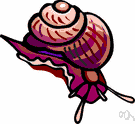gastropod
Also found in: Thesaurus, Medical, Encyclopedia, Wikipedia.
Related to gastropod: Gastropub
gas·tro·pod
(găs′trə-pŏd′)n.
Any of numerous mollusks of the class Gastropoda, characteristically having a single, usually coiled shell or no shell at all, a ventral muscular foot, and eyes and tentacles located on a distinct head, and including the snails, slugs, cowries, and limpets.
gas′tro·pod′ adj.
American Heritage® Dictionary of the English Language, Fifth Edition. Copyright © 2016 by Houghton Mifflin Harcourt Publishing Company. Published by Houghton Mifflin Harcourt Publishing Company. All rights reserved.
gastropod
(ˈɡæstrəˌpɒd) orgasteropod
n
(Animals) any mollusc of the class Gastropoda, typically having a flattened muscular foot for locomotion and a head that bears stalked eyes. The class includes the snails, whelks, limpets, and slugs
adj
(Animals) of, relating to, or belonging to the Gastropoda
gastropodan adj, n
gasˈtropodous adj
Collins English Dictionary – Complete and Unabridged, 12th Edition 2014 © HarperCollins Publishers 1991, 1994, 1998, 2000, 2003, 2006, 2007, 2009, 2011, 2014
gas•tro•pod
(ˈgæs trəˌpɒd)n.
1. any of numerous mollusks of the class Gastropoda, as snails, whelks, and slugs, having a single shell, often coiled, reduced, or undeveloped, and moving by means of a wide muscular foot.
adj. 2. Also, gas•trop•o•dous (gæˈstrɒp ə dəs) belonging or pertaining to the gastropods.
[1820–30; < New Latin]
Random House Kernerman Webster's College Dictionary, © 2010 K Dictionaries Ltd. Copyright 2005, 1997, 1991 by Random House, Inc. All rights reserved.
gas·tro·pod
(găs′trə-pŏd′) Any of various mollusks having a head with eyes and feelers, usually a coiled shell, and a muscular foot on the underside of its body with which it moves. Gastropods include both land-dwelling forms, like land snails and slugs, and aquatic species, like conchs, cowries, and whelks.
Word History Snails, conchs, whelks, and many other similar animals with shells are all called gastropods by scientists. The word gastropod comes from Greek and means "stomach foot," a name that owes its existence to the unusual anatomy of snails. While they don't have feet like ours, exactly, snails have a broad flat "foot" used for support and for forward movement. This foot runs along the underside of the animal—essentially along its belly. The Greek elements gastro-, "stomach," and -pod, "foot," are found in many other scientific names, such as gastritis (an inflammation of the stomach) and sauropod ("lizard foot," a type of dinosaur).
The American Heritage® Student Science Dictionary, Second Edition. Copyright © 2014 by Houghton Mifflin Harcourt Publishing Company. Published by Houghton Mifflin Harcourt Publishing Company. All rights reserved.
ThesaurusAntonymsRelated WordsSynonymsLegend:
Switch to new thesaurus
| Noun | 1. |  gastropod - a class of mollusks typically having a one-piece coiled shell and flattened muscular foot with a head bearing stalked eyes gastropod - a class of mollusks typically having a one-piece coiled shell and flattened muscular foot with a head bearing stalked eyesmollusc, mollusk, shellfish - invertebrate having a soft unsegmented body usually enclosed in a shell abalone, ear-shell - any of various large edible marine gastropods of the genus Haliotis having an ear-shaped shell with pearly interior conch - any of various edible tropical marine gastropods of the genus Strombus having a brightly-colored spiral shell with large outer lip snail - freshwater or marine or terrestrial gastropod mollusk usually having an external enclosing spiral shell slug - any of various terrestrial gastropods having an elongated slimy body and no external shell seasnail - any of several creeping marine gastropods with a spirally coiled shell: whelks; tritons; moon shells; neritids Ancylus fluviatilis, freshwater limpet, river limpet - minute conical gastropod superficially resembling a limpet but living and feeding on freshwater plants nudibranch, sea slug - any of various marine gastropods of the suborder Nudibranchia having a shell-less and often beautifully colored body Aplysia punctata, sea hare - naked marine gastropod having a soft body with reduced internal shell and two pairs of ear-like tentacles bubble shell - marine gastropod mollusk having a very small thin shell physa - any member of the genus Physa cowrie, cowry - any of numerous tropical marine gastropods of the genus Cypraea having highly polished usually brightly marked shells aplacophoran, solenogaster - deep-water wormlike mollusks lacking calcareous plates on the body but having fine slimy spicules on the covering mantle |
Based on WordNet 3.0, Farlex clipart collection. © 2003-2012 Princeton University, Farlex Inc.
Translations
plž
Collins Spanish Dictionary - Complete and Unabridged 8th Edition 2005 © William Collins Sons & Co. Ltd. 1971, 1988 © HarperCollins Publishers 1992, 1993, 1996, 1997, 2000, 2003, 2005
gastropod
n → Bauchfüß(l)er m, → Gastropode m (spec)
Collins German Dictionary – Complete and Unabridged 7th Edition 2005. © William Collins Sons & Co. Ltd. 1980 © HarperCollins Publishers 1991, 1997, 1999, 2004, 2005, 2007